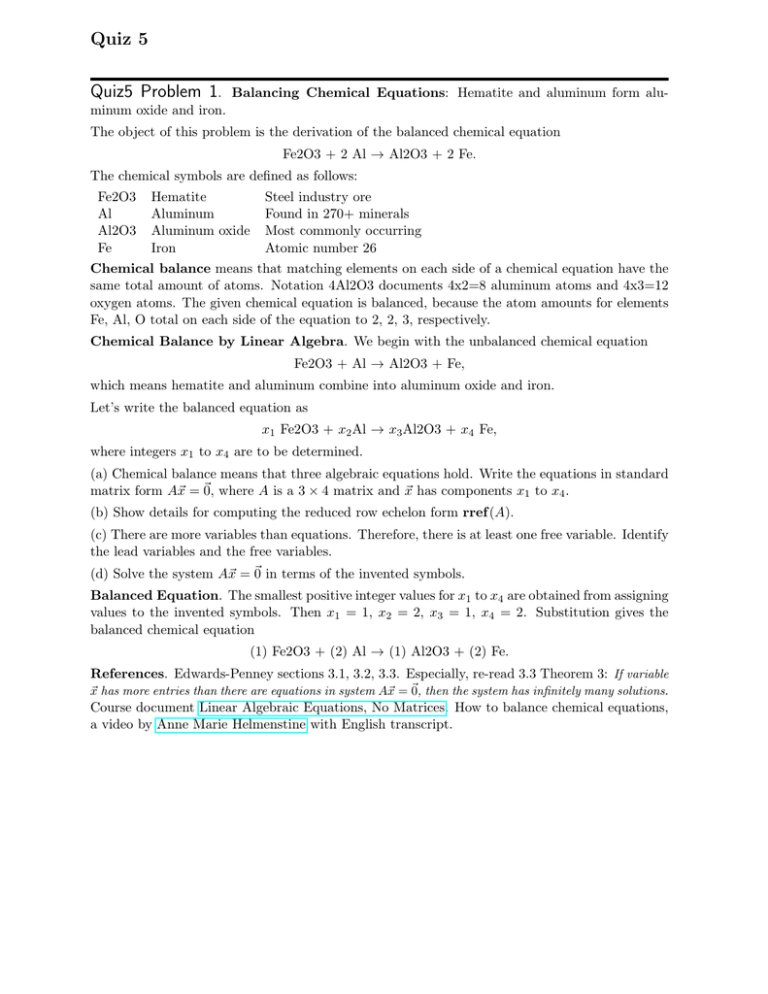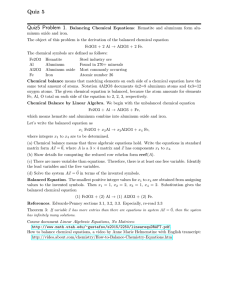Quiz 5 Quiz5 Problem 1
advertisement

Quiz 5 Quiz5 Problem 1. Balancing Chemical Equations: Hematite and aluminum form alu- minum oxide and iron. The object of this problem is the derivation of the balanced chemical equation Fe2O3 + 2 Al → Al2O3 + 2 Fe. The chemical symbols are defined as follows: Fe2O3 Al Al2O3 Fe Hematite Aluminum Aluminum oxide Iron Steel industry ore Found in 270+ minerals Most commonly occurring Atomic number 26 Chemical balance means that matching elements on each side of a chemical equation have the same total amount of atoms. Notation 4Al2O3 documents 4x2=8 aluminum atoms and 4x3=12 oxygen atoms. The given chemical equation is balanced, because the atom amounts for elements Fe, Al, O total on each side of the equation to 2, 2, 3, respectively. Chemical Balance by Linear Algebra. We begin with the unbalanced chemical equation Fe2O3 + Al → Al2O3 + Fe, which means hematite and aluminum combine into aluminum oxide and iron. Let’s write the balanced equation as x1 Fe2O3 + x2 Al → x3 Al2O3 + x4 Fe, where integers x1 to x4 are to be determined. (a) Chemical balance means that three algebraic equations hold. Write the equations in standard matrix form A~x = ~0, where A is a 3 × 4 matrix and ~x has components x1 to x4 . (b) Show details for computing the reduced row echelon form rref (A). (c) There are more variables than equations. Therefore, there is at least one free variable. Identify the lead variables and the free variables. (d) Solve the system A~x = ~0 in terms of the invented symbols. Balanced Equation. The smallest positive integer values for x1 to x4 are obtained from assigning values to the invented symbols. Then x1 = 1, x2 = 2, x3 = 1, x4 = 2. Substitution gives the balanced chemical equation (1) Fe2O3 + (2) Al → (1) Al2O3 + (2) Fe. References. Edwards-Penney sections 3.1, 3.2, 3.3. Especially, re-read 3.3 Theorem 3: If variable ~x has more entries than there are equations in system A~x = ~0, then the system has infinitely many solutions. Course document Linear Algebraic Equations, No Matrices. How to balance chemical equations, a video by Anne Marie Helmenstine with English transcript. Quiz5 Problem 2. Solving Higher Order Initial Value Problems with Linear Algebra. The objective of this problem is to learn how to solve for the constants in a general solution, using given initial conditions. The differential equation and its known general solution are y 0000 − 4y 00 = 0, y(x) = c1 + c2 x + c3 e2x + c4 e−2x . The initial conditions are y(0) = 1, y 0 (0) = 2, y 00 (0) = −1, y 000 (0) = 0. (a) Substitute the general solution into the four initial conditions to obtain the system of equations 1 0 0 0 0 1 0 0 c1 1 1 c 2 −2 2 4 4 c3 c4 8 −8 = 1 2 −1 0 (b) Solve the system of equations and then report the particular solution y(x) so found. Remark.Picard’s existence-uniqueness theorem says that the initial value problem has a unique solution, meaning that the linear algebra problem is in the unique solution case: no free variable. References. Edwards-Penney sections 3.3, 3.4, 5.3. Course manuscript Linear Algebraic Equations, No Matrices. Quiz5 Problem 3. Ehrenfest Urn Model. The Ehrenfest model considers N gas molecules in a box-like container with permeable membrane separating two compartments A and B. The molecules change sides of the membrane. The model describes the number of molecules expected to be in A. Ehrenfest’s model can be formulated as an Urn and Marble model, where urns A and B correspond to the two sides of the membrane and the marbles represent the molecules. Urn Model. Between A and B there are N marbles. At each step, one of the N marbles is chosen at random from either A or B and swapped into the other urn. The state is the number of marbles in A, which is one of the numbers 0, 1, . . . , N . If the marble count in A is i, which is one of 0, 1, . . . , N , then the marble count in A will change to either i + 1 with probability NN−i or else to i − 1 with probability Ni . Let’s consider N = 4 and display the Ehrenfest transition probability matrix, which records the probabilities for the 5 states 0, 1, 2, 3, 4: P = 0 1 4 0 0 0 1 0 0 1 2 0 0 0 0 3 4 3 4 0 0 1 2 0 0 0 0 1 0 1 4 (a) Guess the expected number of marbles in A after a long time. Compare to the steady-state temperature for two bodies of initially different temperature, when held in close contact. (b) Vector ~v = 0 0 0 0 1 represents the state when A contains 4 marbles. Compute ~v P, ~v P 2 , ~v P 3 and explain the answers as marble counts in A. Can you compute ~v P 51 ? References. Edwards-Penney sections 3.3, 3.4, 3.5, 6.3 (transition matrices). Course manuscript Linear Algebraic Equations, No Matrices. Wikipedia Ehrenfest model, especially the 1907 reference to the paper of Paul and Tatjana Ehrenfest.
